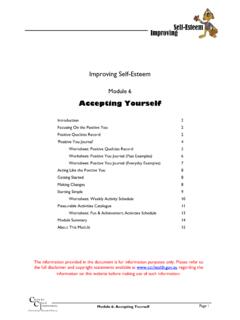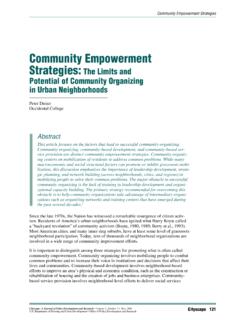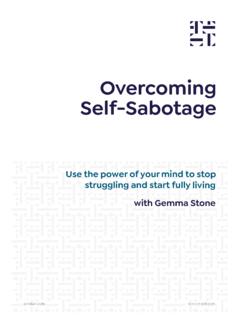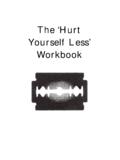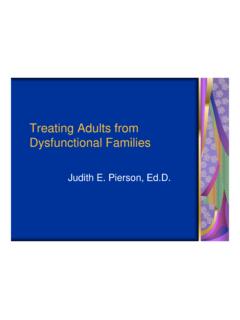Transcription of RESILIENCE TOOLKIT - see me' Scotland
1 RESILIENCE . TOOLKIT . R Remain Positive Look towards the future, think of what you want from life. E Establish Realistic & Achievable Goals This helps give you focus. S Strategies Plan your coping strategies. Don't be afraid to ask for help. I Identify Identify your strengths and be confident in yourself. L Learn from Experience Learn from experience and move on. I Introduce Introduce a positive way of thinking. Focus on the good things in your life. E Enjoy Make time to do the things you enjoy. N Needs Take care of yourself. Keep healthy and fit. C Connect Build healthy relationships with your family, friends and teachers. E Embrace Change Don't dwell on the past. Put your energy into the present to shape your future.
2 PART OF HEALTH PROMOTING YOUTH ORGANISATIONS. RESILIENCE TOOLKIT . Introduction This resource is an initiative of Glasgow CHP South Sector Youth Health Improvement team developed in partnership with The South Strategic Youth Health and Wellbeing Group. This Emotional RESILIENCE TOOLKIT provides practical guidance in promoting the RESILIENCE of young people as part of an integrated health and wellbeing programme. The resource is designed to be used by workers and volunteers working with young people aged 10 and over. What do we mean by RESILIENCE ? RESILIENCE describes a person's capacity to cope with changes and challenges and to bounce back during difficult times. The more resilient someone is, the better they are at getting through tough times, and the better their chances at recovering from experiences of adversity and trauma (Gilligan 2004).
3 RESILIENCE is a key factor in protecting and promoting good mental health. It is the quality of being able to deal with the ups and downs of life. It is a term that can be applied to people of any age. A. young person's ability to be resilient can depend on many different circumstances - they may be able to overcome challenges in one situation but not in another. What RESILIENCE is not! RESILIENCE is not about keeping quiet and putting up with a potentially harmful situation. When encouraging RESILIENCE in young people, it is important to avoid sending the message that it is about being the strong, silent type' who avoids asking for help or communicating their needs or feelings.
4 RESILIENCE needs to be developed with care as not to push unrealistic expectations onto young people. Rather than growing as a person and developing new skills, such messages have the potential to increase the risk of psychological problems in young people. Qualities Associated with RESILIENCE RESILIENCE doesn't develop in isolation. There are many other qualities which impact on and affect RESILIENCE - the main ones can be summarised as follows: being accepted by people whose relationship you value, and from self - esteem . completing tasks you value. Having the qualities of optimism; stickability' and believing that one's own self -EFFICACY. efforts can make a difference.
5 Experience people as reliable, value them and expect them not to betray TRUST. your confidence. A secure attachment relationship creates a secure base from which a young ATTACHMENT. person feels safe to explore the world. RESILIENCE TOOLKIT 1. The provision of a consistent and stable place to live and continuity of SECURE BASE wider relationships which then allow the maintenance or development of attachment relationships. MEANINGFUL Provide a sense of positive identity and a source of self esteem as well as a ROLES source of enjoyment and distraction. AUTONOMY Make decisions and know that it is OK to make mistakes and that you can learn from mistakes. IDENTITY Young people need to know and understand who they are, where they belong and to whom they are important.
6 Helps people to take appropriate actions and make appropriate choices. It is INSIGHT. therefore linked to self efficacy and to initiative. Can help young people to distance themselves from, and therefore reduce, HUMOUR. emotional pain and it can also help them make and sustain relationships. Risk Factors for RESILIENCE It is more challenging for a young person to develop RESILIENCE if there are a number of risk factors apparent in their life. The risk of young people not becoming resilient can be reduced greatly by decreasing these factors and increasing protective factors that are internal and external to the individual. It is particularly helpful for young people to develop positive and caring relationships within family, social, school and community settings, as positive relationships provide opportunities in life.
7 The more protective factors a young person has, the more resilient he/she is likely to be. Protective Factors will be discussed in a later section. There are many different factors that affect a young person's RESILIENCE : FAMILY INDIVIDUAL PEER SCHOOL COMMUNITY. Absence of warm Difficult Lacking friendships Low achievement Poverty and healthy temperament. attachments Risky behaviour. Insufficient Poor attendance Instability of between a child Drug / alcohol relationships with accommodation peers Low connectedness and parent misuse. Criminal to school Low connectedness involvement. Low connectedness Association with to community Psychological Transition from to family and it's delinquent / high problems primary to members risk young people secondary, college /.
8 Violence, abuse or Relationship break university neglect ups Family dysfunction Moving away from family / friends 2 RESILIENCE TOOLKIT . Benefits of RESILIENCE for Young People Young people who are resilient tend to be more hopeful, confident and possess higher self - worth during hard times. They are more likely to overcome challenges, recognise when they need support and develop coping strategies enabling them to handle difficulties more easily in the future. Resilient young people are also more likely to;. Persevere in Develop mutually Have realistic Have a sense of overcoming Set goals respectful expectations independence difficulties relationships Understand their Have good strengths and weaknesses BENEFITS OF RESILIENCE communication skills Have good Recognise and Learn from Empathise with interpersonal Problem solve manage their mistakes others skills own feelings RESILIENCE TOOLKIT 3.
9 Assessing RESILIENCE Three Sources of Resiliency Edith Grotberg of the International RESILIENCE Project defines resiliency in terms of three sources. For a young person to be resilient, he or she needs to have more than one of these strengths. Social and interpersonal supports Awareness of those who support them Who I have I HAVE. Trusting and loving relationships with others Parents, siblings, teachers, friends. Structure at home Clear rules and routines, comprehensible and fair sanctions when breached, praise when followed. Role models Parents, other adults, peers, siblings, who model good behaviour and morality. Encouragement to be independent People who offer praise for growing autonomy.
10 Access to health, education and social care Consistent direct or indirect protection for physical and emotional health. Inner strengths How they view themselves Who I am I AM. Loveable The young person possesses, or is helped to develop qualities that appeal to others. Loving The young person is able to express affection to others, and is sensitive to their distress. Proud of myself The young person feels they have the capacity for achievement and resists discouragement. Responsible The young person accepts and is given responsibilities, and believes their actions can make a difference. Hopeful and trustful The young person has faith in institutions and people, is optimistic for the future and is able to express their faith within a moral structure.
